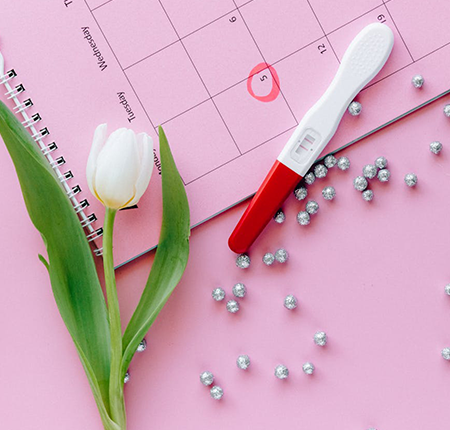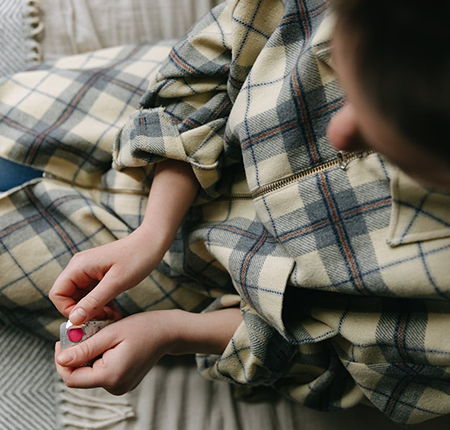
Painful ovulation, also known as ovulalgia or mittelschmerz , is a short-term pain, in the form of stabbing or cramping, that occurs during ovulation. Approximately 40% of women experience painful ovulation throughout their reproductive lives, occasionally or even every month.
There are many ways to relieve the symptoms of ovulalgia, and painful ovulation is generally not a cause for concern. However, it is recommended to talk to your doctor if you have severe pain or if it persists despite treatment.
What is ovulation?
Ovulation is one of the four phases of the menstrual cycle, when an egg is released from an ovary. During each cycle, the egg develops and matures in an ovarian follicle. At ovulation, this follicle stretches and opens to release the egg—actions that can cause discomfort.
After ovulation, the egg survives for 12-24 hours in the woman's body, during which time it can be fertilized by a sperm to produce a pregnancy. This process repeats itself every month, about halfway through the menstrual cycle, around day 14 of a 28-day cycle.
That's why ovulation is the basis of the calendar method , which allows women to track their menstrual cycle and fertile period. The ovulatory period (composed of the day of ovulation, as well as the days before and the 24 hours after) constitutes a woman's fertile period, namely those days when the chances of getting pregnant are highest.
What are the causes of ovulation pain?
The cause of painful ovulation is the process of ovulation itself. Both the stretching action of the ovarian follicle and the expulsion of the egg can cause pain. If the discomfort is not severe, it is perfectly normal.
The pain may be felt as a sharp stabbing or cramping pain, only occasionally or with each ovulation, usually on one side of the abdomen (depending on which ovary released the egg).
But there can be other problems that cause ovulation-like pain, including:
- Endometriosis, ovarian cysts, ovarian torsion, or other conditions of the ovaries or uterus
- Chlamydia and other sexually transmitted infections
- Pelvic inflammatory disease
- An ectopic pregnancy
- Postoperative adhesions, following a cesarean section or other ovarian surgery
Appendicitis

Mittelschmerz syndrome
Mittelschmerz is another name for ovulation pain. The term comes from the German language, by joining the words “mittel” (middle) and “schmerz” (pain), referring to the pain that occurs in the middle of the menstrual cycle, during the ovulation period.
Mittelschmerz is usually not a serious condition and does not require medical attention. However, there are many other possible causes of ovarian pain , so it is recommended to see a doctor for further investigation if you experience this type of discomfort.
Symptoms for painful ovulation
Abdominal pain around day 14 of the menstrual cycle is the main symptom of painful ovulation. Ovulalgia generally manifests as a sharp stabbing or cramping pain, alternately affecting only the left or only the right side (depending on which ovary released an egg that month), and can last from just a few minutes to a full day, or even 2 days.
In addition, painful ovulation may be accompanied by other symptoms:
- Light vaginal bleeding (use 100% organic cotton menstrual products to protect against stains and keep your intimate area dry during this time)
- Clear, viscous vaginal discharge (similar to egg white)
- Migraines, if the pain is severe
- Lower back pain
How can you identify ovulalgia (painful ovulation)?
It's pretty easy to tell if you're having painful ovulation by when the discomfort occurs. To see if there's a connection between your symptoms and ovulation, track your menstrual cycle. Write down the first day of each period and the days you experience pain to see if it occurs around ovulation.
If you notice that about two weeks after the first day of your period you start to feel pain in your lower abdomen, more intense on one side, for no more than 2 days, then you can deduce that the pain is related to ovulation.
Although ovulalgia is not a cause for concern, it is recommended to visit a specialist. There can be several causes of pain in the ovarian area, and the doctor can rule out other conditions after a gynecological examination.

Treatment for ovulation pain
There are many ways to relieve ovulation pain, from natural methods for mild pain to medication for severe pain. Since the pain usually goes away within a few minutes or 1-2 days, in most cases, treatment is not even necessary.
If the pain is intense, rest, bed rest, and rest from physical activities are recommended. Warm baths, warm compresses, or heat patches with natural ingredients can also help reduce cramps.
If the pain persists, you can also try treatment with anti-inflammatory drugs. In case of severe pain, the doctor may recommend treatment with contraceptives that prevent ovulation. In the absence of ovulation, the specific pain will not occur. However, you must keep in mind that you will not be able to get pregnant while taking contraceptives.
Frequently asked questions about painful ovulation
If you have any other questions about painful ovulation, check out this section. We've prepared answers to the most frequently asked questions about this pain, including how it affects fertility and when you should see a doctor.
When should we see a doctor?
Painful ovulation symptoms should go away within 1-2 days at most. If the pain persists for more than 3 days, if it does not go away with physical rest or other treatment, or if other worrying symptoms appear such as vaginal bleeding, fever, nausea and vomiting, it is advisable to consult a doctor.
It is also recommended to see a doctor if the pain recurs repeatedly or if you suspect you are pregnant.
Does painful ovulation affect fertility?
Painful ovulation is not a sign of infertility , nor does it affect your ability to get pregnant in any way. It is simply a symptom of the process by which the egg is released from the ovary. On the contrary, this pain can help you figure out when you are ovulating more easily, which is especially useful if you are using the calendar method.
What conditions can cause pain during ovulation?
Ovulation is the main cause of lower abdominal pain during ovulation. But this pain can easily be confused with symptoms of other conditions, including:
- Endometriosis, a painful condition in which tissue similar to the endometrium (from the uterine cavity) grows outside the uterus.
- Sexually transmitted infections, which cause inflammation and lead to painful ovulation.
- Pelvic inflammatory disease, an infection that affects the reproductive system.
- Ovarian cysts, or fluid-filled sacs that develop on the ovaries.
- Ovarian torsion, when the ovary twists over the ligaments that support it.
- Appendicitis, which consists of inflammation of the appendix.
- Ectopic pregnancy
Adhesions following ovarian surgery

Can pain during ovulation be prevented?
The only way to prevent ovulation pain is to prevent ovulation. This can be done with hormonal contraceptives, only on the recommendation of a doctor.
Is it normal to have ovulation pain every month?
Ovulation pain is normal and does not pose a health risk. It is simply an indicator of ovulation.
However, if the pain is severe, does not respond to treatment, persists for more than 3 days, or is accompanied by other worrisome symptoms, it is recommended to visit a doctor to check if there are other causes behind these symptoms.
reference
To produce this article, I verified and retrieved information from the following sources:
1. Cleveland Clinic, “Ovulation Pain”: https://my.clevelandclinic.org/health/diseases/9134-ovulation-pain-mittelschmerz
2. NHS, “Ovulation pain”: https://my.clevelandclinic.org/health/diseases/9134-ovulation-pain-mittelschmerz
3. Better Health Channel, “Ovulation pain”: https://my.clevelandclinic.org/health/diseases/9134-ovulation-pain-mittelschmerz
4. Mayo Clinic, “Mittelschmerz”: https://www.mayoclinic.org/diseases-conditions/mittelschmerz/symptoms-causes/syc-20375122
5. Verywell Health, “Ovulation Pain and Relief Options”: https://www.verywellhealth.com/ovulation-pain-8628062
6. Healthline, “Why Ovulation Pain Shouldn't Be Ignored”: https://www.healthline.com/health/pregnancy/ovulation-pain
7. NIH, “Mittelschmerz”: https://www.ncbi.nlm.nih.gov/books/NBK549822/
8. WebMD, “Painful Ovulation (Mittelschmerz)”: https://www.webmd.com/women/mittelschmerz-pain
9. MedlinePlus, “Mittelschmerz”: https://medlineplus.gov/ency/article/001503.htm
10. University of Florida Health, “Mittelschmerz”: https://ufhealth.org/conditions-and-treatments/mittelschmerz
Photo source: Pexels.com






















